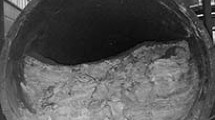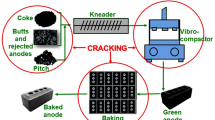The causes of cone formation on the face of carbon anodes in aluminum electrolyzers are examined. The mechanism of cone formation has not been studied well enough to reduce the coning frequency in practice. In addition, many scientists and experts believe that work on the development and implementation of measures for the prevention of cones is economically inefficient. Data on two fundamental mechanisms of cone formation have now been published: carbon reduction on the anode face and individual sections of the anode falling behind in oxidation. Electrolytic reduction can be secured by bringing carbon to the surface of the anode. As a result of the appearance electrophoresis, carbon particles can move in the direction of one of the electrodes, increasing or decreasing the carbon flux.







Similar content being viewed by others
References
E. A. Yanko, Anodes of Aluminum Electrolyzers, Ruda i Metally, Moscow (2001).
B. Rolofs and N. Wai-Poi, “The effect of anode spike formation on operational performance,” Light Metals, 189–193 (2000).
N. Wai-Poi and B. Rolofs, “Impact of energy management and superheat on anode spike formation,” Light Metals, 535–540 (2001).
H. Gudmundsson, “Anode dusting from a potroom perspective at Nordural and correlation with anode properties,” Light Metals, 471–476 (2011).
K. Fetter, Electrochemical Kinetics, Khimiya, Moscow (1967).
M. Smoluchowski, “Bounds of the validity of the second law of thermodynamics,” Usp. Fiz. Nauk, 93, 12 (1967).
O. N. Grigorov, Electrokinetic Phenomena, Izd. LGU, Leningrad (1973).
N. Richards, “The dynamics of components of the anodic overvoltage in the alumina reduction cell,” Light Metals, 521–529 (1998).
A. M. Vinogradov, A. A. Vlasov, V. Yu. Bazhin, et al., “Concentration fields of a high-power aluminum electrolyzer,” Metallurg, No. 4, 77–83 (2012).
Yu. G. Mikhalev, I. P. Vasyunina, and A. M. Vinogradov, “Carbon particles and aluminum carbide in the electrolytes of aluminum baths,” in: Aluminum in Siberia: Coll. Articles, Bona Kompani, Krasnoyarsk (2006), pp. 71–75.
V. Cherncova, V. Danek, A. Sikny, et al., “Dissolution of carbon and Al4C3 in cryolite,” in: 11th Int. Aluminium Symp., Trondheim, Norway (2001), pp. 271–279.
R. Udegärd, Ä. Stertenand, and J. Thonstad, “On the solubility of aluminium carbide in cryolitic melts – influence on cell performance,” Light Metals, 295–302 (1987).
V. M. Sizyakov, V. Yu. Bazhin, D. D. Sharipov, and R. Yu. Feshchenko, “Composition stabilization of the electrolyte in a high-current aluminum electrolyzer,” Tsvet. Metallurg., No. 5, 14–19 (2011).
Author information
Authors and Affiliations
Corresponding author
Additional information
Translated from Metallurg, No. 10, pp. 79–83, October, 2016.
Rights and permissions
About this article
Cite this article
Polyakov, P.V., Vlasov, A.A., Mikhalev, Y.G. et al. On Cone Formation on Burnt Anode Face in Aluminum Electrolyzers. Metallurgist 60, 1087–1093 (2017). https://doi.org/10.1007/s11015-017-0411-2
Received:
Published:
Issue Date:
DOI: https://doi.org/10.1007/s11015-017-0411-2




